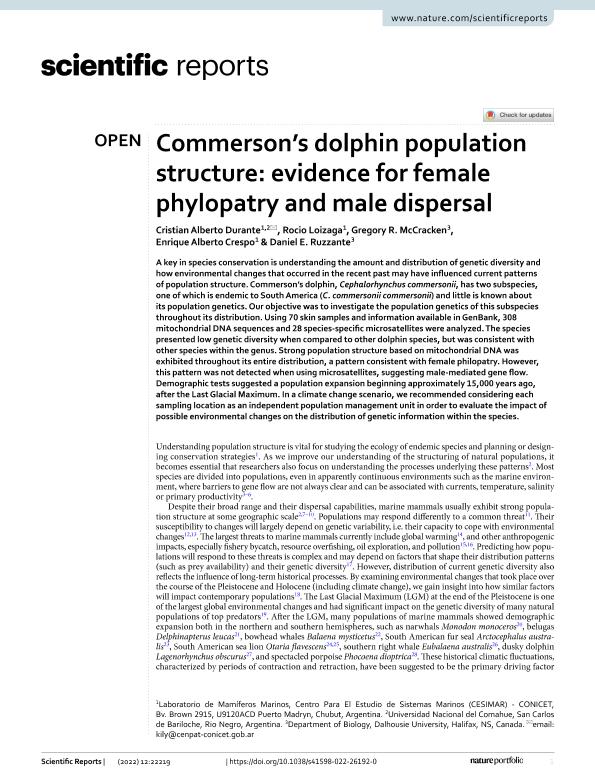Artículo
Commerson’s dolphin population structure: evidence for female phylopatry and male dispersal
Durante, Cristian Alberto ; Loizaga de Castro, Rocio
; Loizaga de Castro, Rocio ; McCracken, Gregory R.; Crespo, Enrique Alberto
; McCracken, Gregory R.; Crespo, Enrique Alberto ; Ruzzante, Daniel E.
; Ruzzante, Daniel E.
 ; Loizaga de Castro, Rocio
; Loizaga de Castro, Rocio ; McCracken, Gregory R.; Crespo, Enrique Alberto
; McCracken, Gregory R.; Crespo, Enrique Alberto ; Ruzzante, Daniel E.
; Ruzzante, Daniel E.
Fecha de publicación:
12/2022
Editorial:
Nature
Revista:
Scientific Reports
ISSN:
2045-2322
Idioma:
Inglés
Tipo de recurso:
Artículo publicado
Clasificación temática:
Resumen
A key in species conservation is understanding the amount and distribution of genetic diversity and how environmental changes that occurred in the recent past may have influenced current patterns of population structure. Commerson’s dolphin, Cephalorhynchus commersonii, has two subspecies, one of which is endemic to South America (C. commersonii commersonii) and little is known about its population genetics. Our objective was to investigate the population genetics of this subspecies throughout its distribution. Using 70 skin samples and information available in GenBank, 308 mitochondrial DNA sequences and 28 species-specific microsatellites were analyzed. The species presented low genetic diversity when compared to other dolphin species, but was consistent with other species within the genus. Strong population structure based on mitochondrial DNA was exhibited throughout its entire distribution, a pattern consistent with female philopatry. However, this pattern was not detected when using microsatellites, suggesting male-mediated gene flow. Demographic tests suggested a population expansion beginning approximately 15,000 years ago, after the Last Glacial Maximum. In a climate change scenario, we recommended considering each sampling location as an independent population management unit in order to evaluate the impact of possible environmental changes on the distribution of genetic information within the species.
Archivos asociados
Licencia
Identificadores
Colecciones
Articulos(CESIMAR)
Articulos de CENTRO PARA EL ESTUDIO DE SISTEMAS MARINOS
Articulos de CENTRO PARA EL ESTUDIO DE SISTEMAS MARINOS
Citación
Durante, Cristian Alberto; Loizaga de Castro, Rocio; McCracken, Gregory R.; Crespo, Enrique Alberto; Ruzzante, Daniel E.; Commerson’s dolphin population structure: evidence for female phylopatry and male dispersal; Nature; Scientific Reports; 12; 1; 12-2022; 1-12
Compartir
Altmétricas



